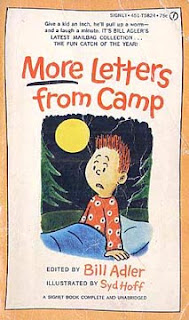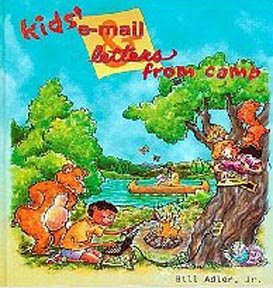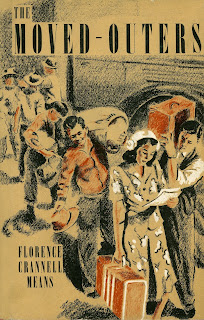SCHOOL’S OUT FOR SUMMER
School days, school days,
Dear old golden rule days.
'Readin' and 'ritin' and 'rithmetic,
Taught to the tune of a hick'ry stick.
You were my queen in calico,
I was your barefoot bashful beau,
You wrote on my slate,
“I love you, Joe,”
When we were a couple of kids.
Everyone knows this song, right?
We used to sing it in grade school, probably not understanding the references to calico or slates -- and completely unaware that if our teacher ever raised one of those hick’ry sticks to us, we could sue the school seven ways to Sunday. I wonder if kids today still sing this song in music class. ...Oh yeah, most school systems have cut music classes due to lack of funding for arts education.
One of the reasons the song is embedded in my brain is because, every September on the first day of school, my mother would wake us up singing this song.
She had a different song for the last day of school in June. And, unlike “School Days,” this one seems to be almost unknown. I did a few Google searches for the lyrics, but found only one vague reference -- as opposed to “School Days” which yields thousands of online hits.
Here are the lyrics for the end-of-school song:
Put away your books and papers,
Closing time has come.
School is over, studies ended,
Now we’re going home.
School’s a very fine place to be
Nothing like it for you and me.
Now we turn our faces homeward quite merrily.
Does this song ring a (school) bell for anyone? To place it in context, I should add that my mother learned the song when she was going to school in Southern Indiana. She would not want me to reveal the decade. So suffice it to say that she attended school in Southern Indiana...when Roosevelt was president.
Notice I didn’t say which Roosevelt.
TO THE TUNE OF A HICKORY STICK
That line from “School Days” provided the title for a 1978 novel by Robbie Branscum. Known for her rural novels, Ms. Branscum had a rather unlikely background for a modern author. Born in 1934 on a farm outside Big Flat, Arkansas, she was raised in extreme poverty by her sharecropper grandparents and was forced to drop out of school by eighth grade. She was married at fifteen, divorced at twenty-five, and spent several years farming and collecting welfare.
One thing Robbie Branscum always had going for her was a love of reading. THE ENCYCLOPEDIA OF ARKANSAS says, “The one-room school she attended held two orange crates filled with books, books that offered her an escape from her abusive grandmother and a glimpse into worlds far beyond her own.” As an adult she would discover public libraries.
Her first children’s book, ME AND JIM LUKE was published 1971, and was followed by twenty more including the aforementioned TO THE TUNE OF A HICKORY STICK, as well as a trilogy about a girl growing up in the Arkansas hills (JOHNNY MAY, 1976; THE ADVENTURES OF JOHNNY MAY, 1984; JOHNNY MAY GROWS UP, 1987), an Edgar Award-winning mystery, THE MURDER OF HOUND DOG BATES (1982), and an autobiographical novel called THE GIRL (1987.)
Years after the author’s death, her daughter Deborah, also a writer, wrote this about her mother: “As a country gal who grew up barefoot, she was never comfortable in cities, formal clothing, or places more than two floors high. Once she traveled to San Francisco for a meeting with an editor on one of the top floors of a downtown skyscraper but never made it. She fled the elevator on the second or third floor and the editor had to come down and meet with her in the ladies room.”
That “country gal” attitude comes through in novels which are, by turns, humorous, painful, honest, and authentic in providing a clear-eyed look at often economically-deprived rural youth.
Although no longer in print, Robbie Branscum’s work deserves rediscovery by twenty-first century readers.
SCHOOL’S NOT ALWAYS OUT FOR SUMMER
The lyric “school is over, studies ended,” may be true for most kids...but some are about to turn right back around and start summer school. I actually took a couple summer classes back when I was in grade school. Several decades later I can’t remember a thing I learned in those classes, but do remember that I learned something about duplicity that summer. Every day at eleven, an older student came around to each classroom with a wheeled cart, delivering doughnuts to the teachers. We students didn’t get any. I still remember the very affected, “adult” way this girl would chat and laugh with the teachers, as the teachers decided whether they wanted plain or frosted or powdered-sugared. And then, while the teacher would dig around in her purse for fifteen cents to pay for the treat, the doughnut girl would gaze around the classroom as if to say, “Look how important I am. The rest of you peons are sitting in a hot classroom with math books. But I’ve got a cart. And doughnuts. I Am...the Doughnut Girl.” Sometimes the teacher would give the D.G. a quarter and say, “Keep the change” and the girl would loudly reply, “FOR ME?” and then s-l-o-w-ly put it in her pocket, making sure we all saw her.
Then, after all her deliveries were made, she’d come back down the hallway, s-l-o-w-l-y passing our classroom door with her clattering cart...and powdered sugar on her face!
We hated her.
The worst thing about her was that, every single morning I’d see her standing outside the school door with her best friend, smoking cigarettes and slamming all the teachers: One teacher never gave her a tip. Another one was “a fat pig who shouldn’t eat doughnuts anyway.” Then, in the midst of all this complaining, some of those very teachers would come right up the walkway to enter the building and this girl would hold her cigarette behind her back, put on a Big Smile (and I capitalize those two initials intentionally) and chat in that very affected, “adult” way about how she’d see them later that morning with their doughnuts.
The teachers seemed perfectly charmed -- although, looking back, I can’t help but believe that some of them saw right through her act. I mean, surely they saw the smoke from her lighted cigarette rising from over her shoulders and the back of her head?
So anyway, I got through summer school without learning anything academic, but I did encounter a girl I can put in a novel someday. ...And speaking of novels, here are a few summer school stories to share. Some of the kids, like Stanford Wong, are attending because they flunked a class during the regular school year. Others, such as the protagonists of THE WILD GIRLS, are attending an elite summer session for young writers.
 THE FARTHER YOU RUN by Davida Hurwin. A watered-down sequel to the heart-wrenching A TIME FOR DANCING.
THE FARTHER YOU RUN by Davida Hurwin. A watered-down sequel to the heart-wrenching A TIME FOR DANCING.SUMMER SCHOOL : WHAT GENIUS THOUGHT THAT UP? by Henry Winkler and Lin Oliver. Yeah, that Henry Winkler -- writing again about his dyslexic alter-ego Hank Zipzer
STANFORD WONG FLUNKS BIG TIME by Lisa Yee. And if Stanford wants to be on the basketball team, he needs to pass summer school English.
THE LIGHTNING THIEF by Rick Riordan. Even demigods have to attend summer school.
THE GREAT INTERACTIVE DREAM MACHINE by Richard Peck. Summer school kids create a computer that fulfills dreams.
 EMPRESS OF THE WORLD by Sara Ryan. Attending a summer program for gifted teens, a girl finds an unexpected romance.
EMPRESS OF THE WORLD by Sara Ryan. Attending a summer program for gifted teens, a girl finds an unexpected romance.CASTRATION CELEBRATION by Jake Wizner. Teens. Arts program. Sex.
THE METHOD by Paul Robert Walker. Albie’s summer high school drama program helps him accept both himself and others.
THE WILD GIRLS by Pat Murphy. This was one of my picks for the Newbery a couple years back. It didn’t win...but should have at least been an Honor Book.
HELLO MUDDER, HELLO FADDER
Those who successfully avoid summer school might still find themselves with a bus ticket for summer camp.
Summer camp can be a grim, life-altering experience (see THE GOATS by Brock Cole) or much more lighthearted (HAIL, HAIL, CAMP TIMBERWOOD by Ellen Conford; THERE’S A BAT IN BUNK FIVE by Paula Danziger; SLOT MACHINE by Chris Lynch.)
For a while there, THE GOATS was a very big deal -- mentioned frequently in critical studies, assigned for school reading, often cited as one of the “very best” children’s books of recent years. ...Maybe it’s just me, but I rarely hear Cole’s novel discussed these days. Has this book’s reputation lost some of its luster?
Following a discussion of THE GOATS with comments on Bill Adler’s LETTERS FROM CAMP pretty much defines the phrase “going from the sublime to the ridiculous.” But one has to acknowledge the huge success of the latter title, which was first published in 1961 and has been a part of our culture ever since. Is there any beach house or cabin that doesn’t have a waterlogged paperback copy of LETTERS FROM CAMP sitting on a windowsill or shelf? It’s perfect beach reading, composed of silly missives supposedly sent by campers to their parents and illustrated by children’s book stalwart Sid Hoff. Adler knew he had a good thing with this idea and went on to publish MORE LETTERS FROM CAMP (1966), HIP KIDS’ LETTERS FROM CAMP (1971), STILL MORE LETTERS FROM CAMP (1973) and AGAIN, MORE LETTERS FROM CAMP (1976.)

I especially got a kick out of this volume, which was published in 2000:

Talk about things changing with the times, now the kids are sending e-mails -- and the book was written by the author’s son, Bill Adler, Jr!
MOONWALKING INTO HISTORY?
Like everyone else who was alive back then, I remember exactly where I was when I heard Elvis Presley died. It was startling news...but I felt a bit removed from the ensuing media hoopla. After all, Elvis was from an earlier generation and had been a big star long before I was even born. And, let’s face it, he was awfully old when he died...all of 42.
Then came this week’s news about an iconic figure from my own generation. Even though he was 50 -- eight years older than Elvis -- my first thought was: “Wow, he died so young!”
Michael Jackson was only a couple months older than I am, so of course I felt as though I’d grown up with him. I was never a huge fan of his music, but I’ll admit I bought a few of his 45s when I was growing up. (If you are under the age of thirty, I guess I need to explain that a “45” was a vinyl disc, about the size of a Lean Cuisine Pizza -- only thinner -- that produced music when played on a machine called a stereo.) And even though I didn’t have any of his later recordings, they were of course, ubiquitous on the radio and TV and really were the “soundtrack of our lives.” And I always followed the news about Michael Jackson in newspapers and magazines -- though I was often horrified by what I read.
In the last couple days I’ve been wondering if Michael Jackson was only relevant to people my age or older. Do kids growing up today know him, or did they view him as a distant, elderly figure? After all, he hadn’t had a hit record in ages.
However, looking at some recent children’s and young adult books, I was surprised to see how often his name was cited. Often the comments were fairly rude (in one of the following titles, a character wonders about “the whereabouts of Michael Jackson’s old nose.” Ouch.) but the fact remains, he WAS mentioned in dozens of contemporary books for contemporary readers. Here are just a few, published within the last couple years:
BLACK RABBIT SUMMER by Kevin Brooks ("Bad?" Pauly grinned. "You mean baad like Michael Jackson? ...")
SO NOT HAPPENING by Jenny B. Jones.
STONEWALL HINKLEMAN AND THE BATTLE OF BULL RUN by Sam Riddleburger and Michael Hemphill.
DEAD GIRL DANCING by Linda Joy Singleton ("... Gloves? I thought, surprised. That style went out with Michael Jackson.)
GEEK CHARMING by Robin Palmer.
BETWIXT by Tara Bray Smith.
BOY MINUS GIRL by Richard Uhlig.
GAMER GIRL by Mari Mancusi.
SUCK IT UP by Brian Meehl (“When I think of vampires, I think Dracula, Lestat, Michael Jackson...”)
There are also reference to MJ in several of Meg Cabot’s popular novels; NICK & NORAH’S INFINITE PLAYLIST by by Rachel Cohn and David Levithan; this year’s Printz winner, JELLICOE ROAD by Melina Marchetta, and one of last year’s Newbery Honors, FEATHERS by Jacqueline Woodson.
That’s pretty amazing. And it makes me wonder if Michael Jackson, for all his baggage, will eventually have an even bigger role in future children’s books. Twenty years ago, who would have thought Elvis Presley would one day be a title figure in numerous volumes:

ANOTHER ICONIC FIGURE
Then there’s the sad story of Farrah Fawcett. Her death was the lead-story for all of five hours before she was pushed off the front pages by Michael Jackson. Farrah hasn’t had a huge role in children’s books so far, though a few titles make reference to her famous haircut and the YA novel FREAK SHOW by James St. James contains a snarky putdown. But believe it or not, she too is briefly cited in a Newbery Honor Book -- CRAZY LADY by Jane Leslie Conly.
I DIDN’T KNOW THAT
Thanks to all who contributed comments on this past week’s blogs.
I was fascinated to hear Jane Yolen’s insights on the PRINCE OF EGYPT movie and books:
When "Prince of Egypt" came out, I wrote the picture book, Lynn Reid Banks did the novelization. Or an accompanying novel. We took the money and ran. Neither book (or movie as far as I know) ever made its money back.
But I accomplished what I set out to do when I finally accepted it: elevating the language back to the Biblical language from the movie's Yo Mo, leaving out the car chase (well, the chariot chase) etc.
And Monica Edinger has me very curious about why Rose Kennedy had the book PENROD in her boudoir:
This March I had a tour of the JFK Presidential Birthplace which was bought back by the family decades later and restored under Rose Kennedy's direction in 1967. Fascinating in terms of her memory, her wish to memorialize her son, and more. But I write because I was completely fascinated that she arranged to have a copy of Penrod on display in her private "boudoir" --- a tiny room of the master bedroom. Have always wondered what she meant by that. I mean, Penrod isn't exactly typical boudoir reading matter.
Daughter Number Three contributed some comments on Virginia Lee Burton. She has some material on Ms. Burton at her blog and points us toward some special events and showings at the Cape Ann Historical Museum.
A LAURA/MARY DILEMMA
A friend sent me this marketing piece for Kate DiCamillo’s forthcoming children’s book, THE MAGICIAN’S ELEPHANT. It’s a piece of chocolate shaped just like an elephant:

Of course I am now faced with a dilemma. Do I eat the chocolate or save it for a souvenir?
It does look rather tasty.
And I wonder how long it will last if I don’t eat it. I mean, if I put it away with all my other book ephemera, won’t it eventually melt and ruin all my other children’s book souvenirs?
Whenever I’m faced with this type of dilemma I always think of Laura and Mary from LITTLE HOUSE ON THE PRAIRIE.
Do you remember the Christmas scene in the original made-for-tv movie in which Mr. Edwards arrives on Christmas with gifts for each of the girls -- including a tin cup and a piece of striped candy. Mary stares at hers reverently and says, “I”m going to save mine.” Laura says, “I’m not!” and chomps into it.
The scene in the book is a little more austere. In the novel, Laura takes one lick -- just one -- from her candy stick, while Mary “who was not so greedy” saves hers for later.
I guess there are two types of people in this world: you’re either a Mary, disciplined enough to save things for a rainy day...or a Laura, who can’t wait to take a big bite of life.
So far I haven’t decided what I’m going to do -- have it for dessert tonight or let it sit around till it turns waxy and white. (Gives new meaning to the phrase “white elephant.)
While I’m deciding, let me take this opportunity to say thanks for visiting Collecting Children’s Books. Hope you’ll return.




































